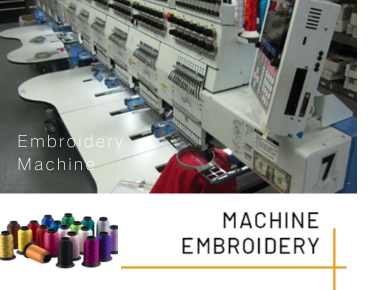Say Goodbye to Puckering: Embroidery Tips & Tricks/Eagle Digitizing
Machine embroidery can transform simple fabrics into
stunning works of art. However, one of the most common and frustrating issues
faced by embroiderers is puckering. Puckering can ruin the appearance of your
design, making it look unprofessional and sloppy. Let’s dive into how to
prevent this pesky problem and ensure your embroidery projects come out perfect every time.
Understanding
Puckering in Machine Embroidery
What is Puckering?
Puckering occurs when fabric wrinkles or gathers around the stitched
area, creating an uneven, bumpy surface. It’s the nemesis of every embroiderer,
distorting your design and reducing the quality of your work.
Common Causes of Puckering
Several factors contribute to puckering, including incorrect fabric
choice, improper hooping, and incorrect machine settings. Even the thread and
needle you use can influence the final outcome.
Why Puckering is a Problem
Puckering isn’t just an aesthetic issue. It can affect the durability
of your embroidery, causing the fabric to wear and tear prematurely.
Additionally, it detracts from the professional look you’re aiming to achieve.
Choosing
the Right Fabric
Best Fabrics for Machine
Embroidery
Stable, non-stretchy fabrics like cotton, linen, and canvas are ideal
for machine embroidery. These fabrics provide a sturdy base that supports your
stitches without distortion.
Avoiding Stretchy and Thin
Fabrics
Thin or stretchy fabrics, such as jersey knit or silk, are more prone to puckering. If you must use these fabrics, consider additional stabilizing techniques to maintain their integrity during embroidery.
Preparing
Your Fabric Properly
Washing and Ironing Techniques
Pre-wash your fabric to remove any sizing or shrinkage that could
occur post-embroidery. Iron the fabric thoroughly to ensure it is smooth and
wrinkle-free before you begin stitching.
Using Fabric Stabilizers
Fabric stabilizers provide the necessary support to your
fabric, helping to prevent puckering. Choose the appropriate stabilizer based
on your fabric and design complexity.
Selecting
the Right Stabilizer
Different Types of Stabilizers
There are several types of stabilizers: cut-away, tear-away,
wash-away, and adhesive. Each type serves different purposes and is suited to
different fabrics and designs.
How to Choose the Right
Stabilizer for Your Project
For stretchy fabrics, cut-away stabilizers provide the most support.
Tear-away stabilizers are great for stable fabrics. Wash-away stabilizers work
well for delicate fabrics where residue would be problematic.
Hooping
Your Fabric Correctly
Tips for Proper Hooping
Proper hooping is crucial. Ensure that the fabric is taut but not too
stretched in the hoop. The fabric should lie flat without any ripples.
Avoiding Hooping Mistakes that
Cause Puckering
Avoid pulling the fabric too tightly in the hoop as this can cause
puckering when the tension is released. Always double-check that the fabric is
evenly hooped.
Adjusting
Your Machine Settings
Optimal Tension Settings
Incorrect thread tension is a major cause of puckering. Adjust your
machine’s tension settings based on the fabric and thread you are using.
Conduct a test stitch to find the optimal tension.
Correcting Stitch Density
High stitch density can lead to puckering as too many stitches in a
small area pull the fabric. Adjust your design to reduce stitch density where
possible.
Using
the Right Needles and Threads
Needle Types and Sizes
Choose the correct needle type and size for your fabric. A larger
needle may be necessary for heavier fabrics, while a finer needle works better
for delicate fabrics.
Choosing Quality Threads
Quality threads reduce the risk of puckering. Polyester and rayon
threads are popular choices due to their strength and smooth finish. Avoid
cheap, low-quality threads that are prone to breakage.
Testing
Your Design Before Embroidering
Importance of Running a Test
Stitch
Always run a test stitch on a fabric scrap. This helps you identify
any issues with your design, stabilizer, or machine settings before you start
on the final piece.
Making Adjustments Based on Test
Results
Use the test stitch results to make necessary adjustments. This might
include altering the tension, changing the stabilizer, or tweaking the design.
Layering
and Placement Techniques
Proper Layering to Avoid
Puckering
Layer your fabric and stabilizer correctly. For tricky fabrics,
consider using multiple layers of stabilizer for added support.
Placement Tips for Intricate
Designs
Place intricate designs carefully to avoid areas that are more prone to puckering, such as seams or edges. Proper placement can make a significant difference in the final outcome.
Embroidery
Speed and Its Impact
How Speed Affects Puckering
Embroidery speed can affect puckering. Slower speeds reduce the risk
of fabric shifting and puckering, especially on delicate fabrics.
Finding the Right Speed for Your
Machine
Experiment with different speeds to find what works best for your
machine and project. Most modern machines allow you to adjust the speed
settings easily.
Handling
Different Fabric Types
Special Techniques for Delicate
Fabrics
Delicate fabrics require special care. Use finer needles and lighter
stabilizers. Be gentle during hooping and handling to avoid damage.
Tips for Thick and Heavy Fabrics
For thick fabrics, use a stronger needle and sturdy stabilizer. Ensure
your machine can handle the thickness without skipping stitches or causing
puckering.
Preventing
Puckering in Large Designs
Breaking Down Large Designs into
Sections
Large designs can be prone to puckering due to the extensive stitch
area. Break down the design into smaller sections and embroider one section at
a time.
Stabilization Techniques for
Large Projects
Use multiple layers of stabilizer and ensure the fabric is securely
hooped. Consider using basting stitches to hold the fabric and stabilizer
together.
Avoiding
Over-Embellishment
Keeping Designs Simple to
Prevent Puckering
Simplicity is key. Overly intricate designs with high stitch density
increase the risk of puckering. Keep designs balanced to suit the fabric's
strength.
Balancing Design Complexity and
Fabric Strength
Match your design complexity with the fabric’s strength. Heavier fabrics can handle more complex designs, while lighter fabrics require simpler patterns.
Using
Toppers for Added Stability
What are Toppers?
Toppers are stabilizers placed on top of the fabric, providing
additional support and preventing stitches from sinking into the fabric.
When and How to Use Toppers
Use toppers on fabrics with texture, like towels or knits. They ensure
stitches remain on the surface, enhancing the design’s visibility and preventing
puckering.
Post-Embroidery
Care
Post-Embroidery Inspection
Once the embroidery is complete, conducting a thorough inspection is
vital. This step allows you to catch any potential issues early on, including
puckering. Puckering often occurs due to improper stabilizing during embroidery
or inadequate handling afterward.
Cleaning and Washing Techniques
Proper cleaning and washing techniques play a crucial role in
maintaining embroidered pieces without causing damage or puckering.
●
Gentle Washing Recommendations: Always opt for
gentle washing methods to protect delicate embroidery threads and fabrics.
Handwashing is ideal, using mild detergent and cool water to preserve the
vibrancy of colors and prevent unnecessary stress on the threads.
●
Temperature and Detergent Considerations: Use
lukewarm water and mild detergent specifically formulated for delicate fabrics
and embroidery. Harsh detergents can weaken fibers and cause colors to fade or
bleed, affecting the overall appearance of the embroidery.
Drying Methods
Choosing the right drying method is crucial to prevent puckering and
maintain the integrity of embroidered designs.
●
Air Drying vs. Machine Drying: Air drying is
often the safest option for embroidered pieces, as it reduces the risk of heat
damage and maintains fabric texture. Lay the embroidery flat on a clean towel
or drying rack, ensuring it is fully supported to avoid stretching or
distorting the design.
●
Avoiding Heat Damage: If machine drying is
necessary, use a low-heat setting or opt for air fluff with no heat. High
temperatures can cause threads to shrink or fabrics to warp, leading to
puckering and irreparable damage to the embroidery.
●
Techniques for Flat Drying: To ensure the
embroidered piece dries evenly and without puckering, gently pat excess water
using a clean, dry towel. Avoid hanging damp embroidery pieces, as this can
cause stretching and distortion of the fabric and threads.
Ironing and Pressing Guidelines
Proper ironing and pressing techniques help maintain the crispness of
embroidery stitches without causing puckering.
●
Proper Ironing Temperatures: Set your iron to a
low or medium heat setting appropriate for the fabric type. Avoid high heat, as
it can melt delicate threads or cause puckering around embroidered motifs.
Always test the iron temperature on a small, inconspicuous area of the fabric
before ironing over embroidered designs.
●
Using a Pressing Cloth: Place a clean pressing
cloth or a thin cotton fabric over the embroidered area before ironing. This
protective layer prevents direct contact between the iron and the embroidery
threads, reducing the risk of flattening or distorting the stitches.
●
Steam vs. Dry Ironing: For stubborn wrinkles or
to revive the embroidery's texture, use steam ironing with caution. Hold the
iron slightly above the fabric surface and release steam in short bursts to
avoid saturating the threads. Dry ironing is preferable for delicate fabrics to
prevent moisture-related puckering.
Troubleshooting
Common Puckering Issues
Quick Fixes for On-the-Spot
Puckering
If puckering occurs, re-hoop the fabric, ensuring it’s taut and
stable. Adjust machine settings and check the thread tension. Sometimes, adding
an additional layer of stabilizer can fix the issue.
Long-Term Solutions for
Persistent Problems
For persistent puckering, review your entire process. Ensure you’re using the correct fabric, stabilizer, and machine settings. Keep a log of what works and what doesn’t for future reference.
Storing
and Handling Your Embroidered Projects
Tips for Proper Storage
Store embroidered projects flat to prevent creases. Use acid-free
tissue paper for added protection and avoid stacking heavy items on top.
Handling Techniques to Maintain
Quality
To prevent the spread of oils and grime, handle embroidered objects
with clean hands. Avoid excessive handling to preserve the quality and
appearance.
Learning
from Experience
Keeping a Journal of Your
Embroidery Projects
Document each project, noting the fabric, stabilizer, needle, thread,
and machine settings used. This journal becomes a valuable resource for future
projects, helping you refine your techniques.
Adjusting Techniques Based on
Past Projects
Analyze past successes and failures to improve your approach. Adapt
techniques based on what you’ve learned, ensuring better outcomes with each
project.
Tips
from the Pros
Expert Advice for Pucker-Free
Embroidery
Professionals emphasize the importance of high-quality materials and
proper preparation. Invest in good stabilizers, needles, and threads to
minimize issues.
Common Mistakes and How to Avoid
Them
Avoid common mistakes like improper hooping, incorrect tension
settings, and using unsuitable fabrics. Learn from these errors to enhance your
embroidery skills.
Preventing puckering in machine embroidery is a combination
of using the right materials, proper preparation, and careful technique. By
understanding the causes and implementing these tips, you can achieve smooth,
professional-looking embroidery every time.



.png)